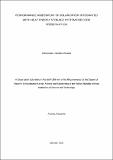| dc.description.abstract | Solar energy is regarded as a clean form of energy because solar radiation can be transformed
into heat energy for different applications such as heating water, generating power, cooking,
and drying food products. The solar dryer integrated with heat energy storage system in this
study was designed to use nitrate salt as a phase change material that can store thermal energy
during sun hours and then be used when the sun is not active. The dryer was tested by drying
1000 g of red peppers in a drying air temperature range of 19.6 – 62.4 °C, the average
temperature was 46 °C and ambient temperature ranges between 19.3 – 37.4 °C. The drying
process of the developed solar dryer was compared with an open sun drying system, each
loaded with 1000 g of red pepper. For 24 hours, the solar dryer maintained colour, flavor and
reduced the moisture content from 86% to the required 10% whereas open sun drying took 36
hours to accomplish the same result. It has been discovered that the payback period is 6.2 years,
which is low compared to the 22-year solar dryer life span. Thus, for 16 years, the solar dryer
will dry free products, which is feasible and economical. | en_US |

